Add more outdoors in 2024
By SARAH LAPSHAN
Senior communications advisor
Michigan Department of Natural Resources
When it comes to nature-based fun and learning, we’ve got you covered. Everyday adventurers, weekend warriors and everyone in between – you’re all welcome in Michigan’s big green gym.
“No matter where you live or where you’d like to go, our state has a wealth of quality public lands offering many opportunities to get you outside,” said Scott Whitcomb, director of the Office of Public Lands at the Michigan Department of Natural Resources. “If your 2024 plans include resolutions for better physical and mental health, less screen time and more days enjoying, supporting and learning about the outdoors, this is a pretty great place to be.”
Here are a few ideas to get started.
Tackle new trails
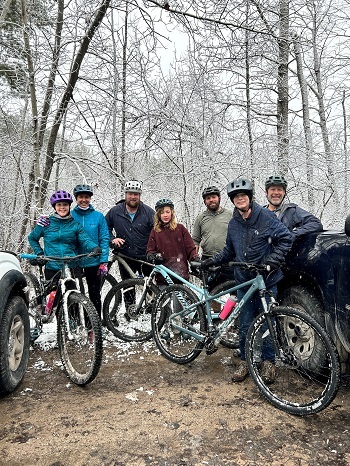
Michigan has more than 13,400 miles of state-designated trails, including multiuse trails that can accommodate more than one type of recreation use. These trails are for hiking, biking, cross-country skiing, paddling, horseback riding, off-road vehicle riding, snowmobiling and more.
To tweak your trails routine:
When you’re ready to blaze your own trail, get everything you need – interactive nonmotorized trail and ORV route maps, snowmobile trail maps, track chair details, etiquette guidance and closures info – at Michigan.gov/DNRTrails.
|
Watch for wildlife
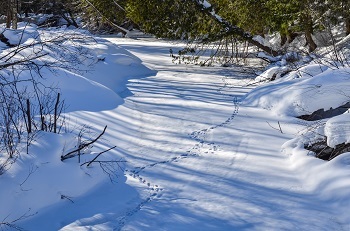
An easy, fun way to enjoy fresh air is to keep an eye out for animal tracks. You can do this year-round, but with tracks and evidence of critters more visible with snow on the ground, winter is one of the best times.
Rachel Lincoln, a DNR wildlife outreach coordinator, said many animals remain active during Michigan winters, both in urban and rural settings, and it’s common to see tracks of deer, squirrels, coyotes, birds and rabbits widespread throughout the state – though the tracks of bobcats, foxes and weasels prove more elusive.
“Small mammals such as shrews, mice and voles will tunnel beneath the snow, leaving lines of raised snow that are easy to spot,” she said. “Following tracks gives insights into animal behavior. You’re like a detective, piecing together what the animal was doing, where it was traveling to and from, whether it was alone or traveling in groups.”
Want to know more? Animal track field guides can help you learn about the tracks you’re seeing. Peterson’s Field Guide on Animal Tracks is a great resource to explore beforehand or take with you in the field. Learn more about plant and wildlife species at Michigan.gov/Wildlife.
|
Try your hand at tree ID
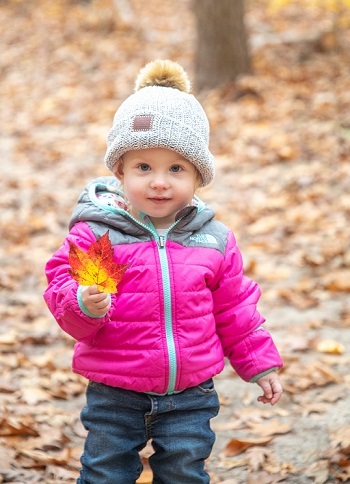
With more than 20 million acres of forest land and expanding urban tree canopy, Michigan knows trees … but do you? Hartwick Pines State Park interpreter Craig Kasmer has some tree-identification tips to keep in mind when you’re out exploring.
Conifers (pine, spruce, fir and cedar, for example) that retain their leaves are easier to ID in the winter. Deciduous trees (like maple, birch and elm) that lose their leaves take more effort to determine.
“The three characteristics to look for are bark, branching and seeds, and the seeds are usually found on the ground at this time of year,” said Kasmer.
For a branching reminder, he suggested the acronym MAD HORSE, because maple, ash, dogwood and horse chestnut all have opposing branching patterns: twigs grow off a branch opposite of each other like our arms from our torso. All other trees/shrubs grow in an alternate pattern.
Some quick tree traits: White oak trees have water-resistant properties that make them great for building boats and wine barrels. Redbud trees have tiny pink flowers that bloom before the trees even grow leaves. The mighty eastern white pine, Michigan's state tree, can grow over 100 feet tall!
Intrigued? Discover more facts about Michigan's trees on the DNR’s native trees webpage.
|
Know your invasives
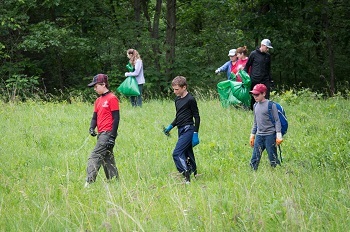
No matter how or where you spend time outdoors, there is something you can do to care for your favorite places: learn about invasive pests and diseases that threaten native plant and animal species.
If certain invasives are given the chance to outcompete native species enough to establish themselves in new ecosystems, they pose a huge risk to Michigan woods and water. Certain species can cause deforestation, reduce fish populations and alter valuable habitat.
It’s easy to help; just know what to look for and report what you see!
Visit Michigan.gov/Invasives to learn more about identifying and reporting problem species; get tips on actions hunters, anglers, boaters and others can take to reduce the spread of invasives; and explore the popular NotMiSpecies webinar series. It covers everything from rock snot (yes, a true aquatic invasive species) to protecting your own backyard or neighborhood from damaging bugs like spongy moth or spotted lanternfly.
|
Volunteer
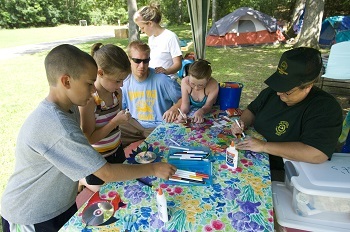
Teaching new hunters about safety, answering campers’ questions and sharing campground program information, pulling invasive plants in state parks’ natural areas, cleaning up illegal dumping sites in the forest, installing fish-spawning structures, gathering water samples from an inland lake, giving lighthouse tours, reporting sick or dead wildlife – these all are things you can do to help Michigan’s natural world and the people who like to spend time in it.
If you want to lend a hand but aren’t sure how to make the leap, visit the DNR’s Get involved webpage. Explore the different volunteer options and see where you have a natural inclination, what feels like the right fit. If Michigan’s great outdoors has given a lot to you over the years, make 2024 the year you give back. You’ll be glad you did.
|
Discover new pursuits

Always wanted to try fishing, hunting, hiking, birding, mushroom hunting or other nifty nature quests, but want a little guidance? The DNR’s Outdoor Skills Academy has just what you need: expert-led outings, all the gear, and time and space to let yourself learn.
“Sometimes a lack of experience with a certain hobby or skill can be intimidating, but the Outdoor Skills Academy removes all of that,” said the DNR’s Ed Shaw, who oversees the program. “Spend a weekend with your son or daughter, partner or best friend – or go solo and make new friends – and enjoy diving into something new that might just become a lifelong passion.”
Upcoming classes include ice fishing and snowshoe building, with more opportunities added throughout the year. Watch for updates and registration details at Michigan.gov/OutdoorSkills.
Michigan’s Becoming an Outdoors-Woman program offers women (18 and older) opportunities to explore outdoor activities in a noncompetitive, supportive atmosphere. The program offers weekend events in February and June in the Upper Peninsula at the Bay Cliff Health Camp north of Marquette.
“BOW truly is a life-changing experience for many of the participants who often find deep and meaningful connections to the outdoors on their very first visit,” said John Pepin, administrator of the program. “There is also a camaraderie, finding of new friends and good times shared by participants and volunteer instructors alike.”
The program has dozens of class offerings ranging from self-confidence, shotgun and rifle shooting and cross-country skiing to fly fishing, paddleboarding, photography, wilderness first aid, archery, backwoods cooking, hiking and more. Sign up for upcoming activities and learn more at Michigan.gov/BOW.
|
Look local

Whitcomb said that state-managed public lands aren’t your only option for getting outdoors. At the local and regional levels, too, you can find quality public recreation resources – neighborhood playgrounds, nature centers, community parks, city-to-city trails and more – that often are available closer to home.
“Such opportunities proved critical during the COVID-19 pandemic, and they continue to provide the safe, welcoming outdoor space people value,” he said.
One place to start the search is the DNR’s Michigan.gov/YourLocalOutdoors website, where you’ll find an interactive map pin-pointing the names, locations, directions and destinations for plenty of places to camp, hunt, fish, boat, bike and more. Most entries offer information such as latitude and longitude, address, contact phone number and link to a dedicated webpage with more specific details and amenities.
Get more outdoor inspiration – including winter fun such as fat-tire biking, stargazing and cross-country skiing – on the DNR's Things to do webpage.
If you’re looking for new opportunities for adventures and recreation in the outdoors, Michigan has what you’re looking for. Add more outdoors to your life in 2024.
|
Check out previous Showcasing the DNR stories in our archive at Michigan.gov/DNRStories. To subscribe to upcoming Showcasing articles, sign up for free email delivery at Michigan.gov/DNREmail.
Note to editors: Contact: John Pepin, Showcasing the DNR series editor, 906-226-1352. Accompanying photos and a text-only version of this story are available below for download. Caption information follows. Credit Michigan Department of Natural Resources, unless otherwise noted.
Text-only version of this story.
Winter mountain biking: A group of holiday mountain bikers stop for a picture on the Norway Ridge Trail near Alpena.
Trail running: Enjoying a sun-filled run at Pinckney Recreation Area in southeast Michigan.
Animal tracks: Animal tracks are pictured crossing the ice of Mud Creek in Gogebic County.
DNR TreeNA sugar maple graphic: A graphic highlighting characteristics of the sugar maple. See nearly two dozen other TreeNA graphics on the DNR’s Michigan trees webpage.
Little leaf hunter: A young girl proudly shows off her find: a red and gold maple leaf picked up in Hoffmaster State Park in Muskegon. Photo courtesy of Michigan state parks photo ambassador Blair Celano, for the Michigan DNR.
Stewardship day: Volunteers at Brighton Recreation Area spread out to locate and remove invasive plants from natural areas at the state park.
Campground host: The campground host at Hayes State Park in Lenawee County helps young campers with a nature-themed art project.
Snowshoe making: Learning to make your own traditional snowshoes at Hartwick Pines State Park in Grayling.
Ice fishing sunrise: A few lone fishing shanties dot the ice at sunrise on Saginaw Bay.
Splash pad: Two little boys cooling off and having fun on the splash pad at Bay City State Park.
|